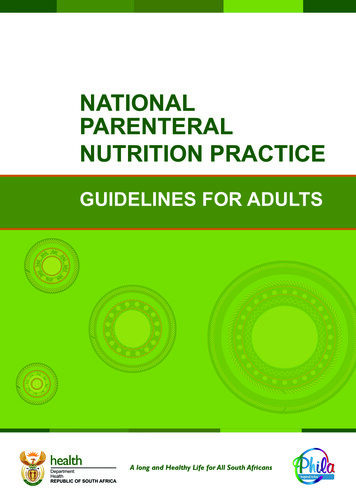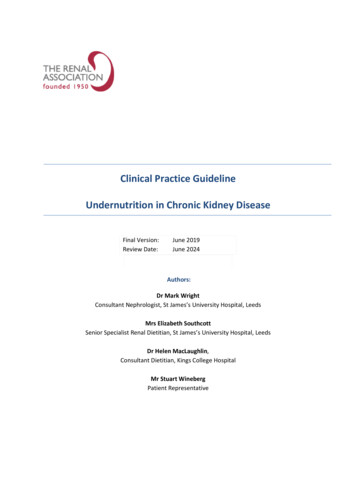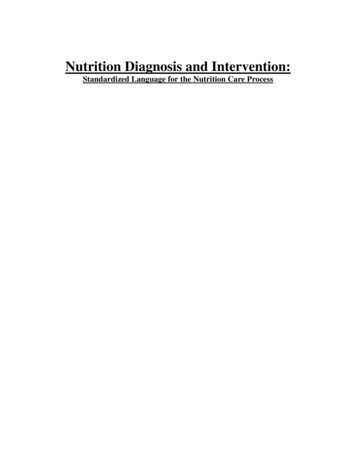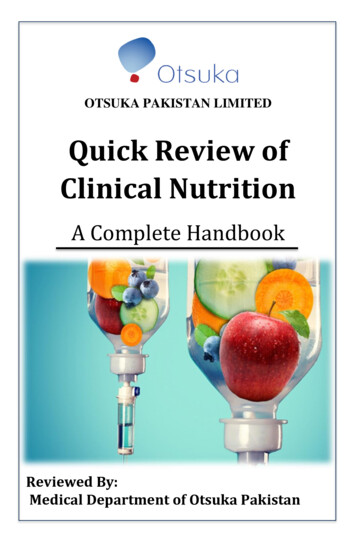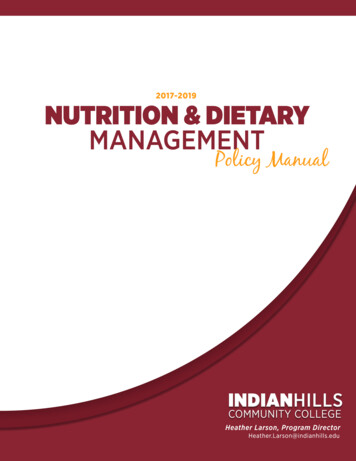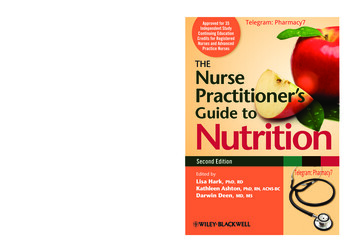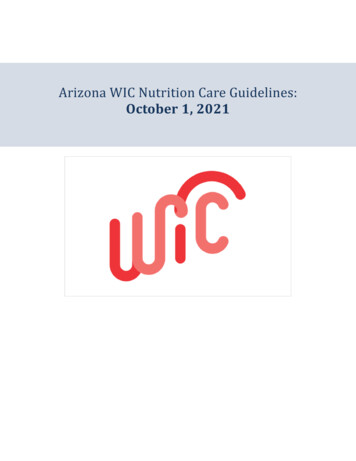
Transcription
NUTRITION ISSUES IN GASTROENTEROLOGY, SERIES #170Carol Rees Parrish, M.S., R.D., Series EditorHave PN (Parenteral Nutrition) –Will TravelAnna PatsyAdriana PanciuNizar SenussiPatients requiring long term parenteral nutrition (PN) may choose to travel at some point. Travelingwith PN requires collaboration among the patient, prescriber, and the infusion pharmacy. Coordinationof PN deliveries and supplies, as well as managing clinical concerns and safety, must be addressedprior to traveling. Self-monitoring, as well as necessary lab tests must be coordinated to effectivelymonitor electrolytes and hydration. Knowing how to reach their providers and where medicalfacilities are located in the event that an emergency should arise is important. While traveling withPN can sometimes be challenging to coordinate, it should not discourage medically stable patientsfrom doing so. This article provides suggestions to clinicians to help their HPN patients travel safely.INTRODUCTIONHome Parenteral Nutrition (HPN) is often used inpatients with intestinal failure, or others unableto consume or absorb nutrients.1 HPN may beshort or long term, depending on the patient’s condition,underlying disease state and future plan of care. Sincepatients on HPN are typically hooked up to theirAnna Patsy, MS RD LD CNSC, Home NutritionSupport Clinician, Cleveland Clinic, DigestiveDisease & Surgery Institute. Cleveland, OHAdriana Panciu, PharmD BCNSP, Nutrition SupportPharmacist, Cleveland Clinic, Center for ConnectedCare, Independence, OH Nizar Senussi, MD, LiverCare Network, Swedish Medical Center, Seattle, WA28infusions 10-14 hours, patients often inquire about theability to travel with PN. Many HPN patients do traveland count on their health care team to provide guidanceon how to plan their travel around their PN infusions.As a clinician, it is important to identify the methodof travel, final destination as well as the duration ofthe trip. A travel letter signed by the patient’s HPNphysician, stating the need for their medical supplies,can be provided for air travel at the patient’s request(see Table 1). It is important that patients contact theirinfusion pharmacy about their upcoming travel well inadvance of travel dates. Infusion pharmacies play anintegral role in providing accommodations for travel. Ifa patient is going to be traveling to multiple locationsPRACTICAL GASTROENTEROLOGY DECEMBER 2017
Have PN (Parenteral Nutrition) – Will TravelNUTRITION ISSUES IN GASTROENTEROLOGY, SERIES #170during a trip, the patient’s infusion pharmacy mayneed to arrange for multiple pharmacies or branchesto service the patient throughout their travels. Whiletraveling with HPN may be a challenge, it can certainlybe done with proper preparation.Case PresentationA 35 year old female reports that she is going on a 10day trip next month. She will be flying to her traveldestination. She has many questions regarding if andhow she can travel with HPN, as she has not doneso before. She is concerned about keeping the bagsrefrigerated during her travels. She has been on thehome nutrition service for 6 months and is currentlygetting weekly labs drawn due to high stoma outputrelated to short bowel syndrome. Her labs have beenrelatively stable for some time now. It is difficult for herto always time her anti-diarrheal agents (loperamide,diphenoxylate-atropine, codeine, etc.) 30-60 minutesprior to meals. Additionally, she will be traveling southTable 1. Sample Travel LetterDate:To Whom it May Concern:(Patient name) is under my care for (disease state) and requires intravenous nutritionalsupport and hydration therapy to sustain nutritional status, hydration, and health. She mustinfuse fluids daily using a portable pump via a central intravenous catheter in her chest. Shemust also add intravenous multivitamins and medications to nutrition solutions daily.The medical supplies and equipment are necessary to sustain her life and health. Her healthand life would be in significant danger if these supplies were withheld for any reason. She hasbeen trained to provide her own care.The equipment and supplies include: Portable pump with carrying case, batteries, power packs, charging apparatus,tubing, syringes and needles. Medication: (list medications added to PN such as insulin, famotidine, etc.) Alcohol, Chlorhexidine, and/or Povidone Iodine preparations such as wipes, padsor swab sticks. Catheter supplies: Dressing change supplies, tape gauze, transparent dressings,gloves, injection caps and Alcohol based hand washes. Parenteral Nutrition (PN) solutions and Intravenous Fluid Solutions (example:0.45%NaCl, 0.9%NaCl, D50.45%NaCl, D50.9%NaCl, 5%Dextrose in water) as needed.Thank you for your attention and consideration to this important matter. For any questionsplease feel free to call my office at (office phone number)Respectfully,Physician’s NamePRACTICAL GASTROENTEROLOGY DECEMBER 2017 29
Have PN (Parenteral Nutrition) – Will TravelNUTRITION ISSUES IN GASTROENTEROLOGY, SERIES #170to a warmer climate. She has a single lumen Hickmancatheter and is independent with dressing changes.After finding out that she cannot swim in the oceandue to her Hickman catheter, she is disappointed, butlooking forward to swimming in the chlorinated poolat the hotel (Note: prescribing physicians vary on theirwillingness to approve their HPN patient swimming in apublic facility). The patient, PN prescriber, and infusionpharmacy must all collaborate and be informed of travelplans. Good communication is crucial, especially if theHPN solution needs to be altered for traveling.Clinical ConcernsDiscussing the signs and symptoms of dehydrationalong with electrolyte abnormalities is important.Review with the patient that if they develop any ofthe following: Signs and symptoms of electrolyteabnormalities/dehydration Signs of infection, (fever, or shakes andchills during their infusion) Central line occlusion/damage, etc.They should report to the closest emergency room(ER) for evaluation. Travelers should always knowwhere the closest ER is should something unexpectedhappen. Identifying location of hospitals along travelroute in advance would also be beneficial to the traveler.Patients should be able to reach their PN prescriber andinfusion pharmacy while they are traveling.It is helpful to know if a patient is traveling to awarmer climate so that steps can be taken to preventdehydration. Additional liter bags of appropriateintravenous (IV) fluids would be beneficial to haveon hand during their travels. It is not uncommon forpatients to express that traveling with HPN bags is quitecumbersome (each bag can weigh up to 10 pounds).They may be concerned about refrigeration or theamount of space they can take up in a vehicle due topumps and necessary supplies (see Figure 1 for anexample of PN supplies for one week).Patients traveling will need to ensure that they haveenough of their oral prescriptions, such as anti-diarrhealagents, anti-secretory agents, etc.; prior to leaving fortheir trip and the name and phone number of a pharmacyclose to their destination should they need somethingcalled in. A word document with all medications used,dose and frequency is a good idea for patients to keepreadily available in their wallet. The patient may alsowork with the pharmacy to create a list of suppliesneeded including a backup infusion pump and evenFigure 1. Example of PN and IVF Supplies for 1 week of Travel30 PRACTICAL GASTROENTEROLOGY DECEMBER 2017
Have PN (Parenteral Nutrition) – Will TravelNUTRITION ISSUES IN GASTROENTEROLOGY, SERIES #170Table 2. Infusion Pharmacies with National CoveragePN Infusion ProviderWebsiteStates CoveredAmerican OutcomesManagement, L.Phttp://www.americanoutcomes.com/All 50 statesAmerita*https://www.ameritaiv.com/35 states: AL, AK, AR, CA, CO, DE, FL, GA,ID, IA, IL, IN, NY, KS, KY, MD, MA, MS,ND, NE, NM, NV, OH, OK, PA, RI, SC, TN,TX, UT, WA, WV, WYBriovaRX (formerlyAxelaCare SpecialtyHome Infusion)*http://www.axelacare.com/node/6717 states serviced: AL, AR, CA, CO, FL,GA, KS, LA, MD, NC, NE, NM, NY, OK, OR,PA, SCBioScrip, Inc.*https://www.bioscrip.com/25 states: Al, CA, CT, FL, GA, IL, KY, LA,MA, ME, MN, MO, MS, NE, NJ, NY, NC,OH, PA, RI, TN, TX, VA, VT, WVCoram CVS/specialtyinfusion services*https://www.coramhc.com/All 50 statesLHC Group Pharmaceutical http://lhcgroup.com/Services25 states: AL, AK, AZ,CA, CO, FL, GA, ID,IL, LA, KY, MA, MD, MO, MS, NC, NV, OH,OR, SC, TX, TN,VA, WA, WVNutrishare, Inchttps://nutrishare.com/All 50 statesOption Care (Recentlypurchased ClinicalSpecialty Infusions,LLC CSI Pharmacy)*http://optioncare.com/ 90% of the US populationParagon Healthcare Inc.http://paragonhealthcare.com/28 states: AK, AL, CO, FL, GA, IA, ID, IL,IN, KS, KY, LA, MN, MO, MS, NC, NE, NM,NY, NV, OH, OK, TN, TX, UT, WI, WV, WYPharmacy Specialistshttp://www.pharmacy-specialists.com 24 states: AK, AZ, CA, CO, CT, FL, GA, IL,IN, IA, KS, LA, MN, MO, NM, NY, OK, PA,SC, SD, TN, TX, WI, WYSoleo Health*http://www.soleohealth.com/48 states – all but AK and HIThriveRx(Subsidiary of DiplomatInfusion Group)*http://www.thriverx.net/All 50 statesVital Care Inc. HomeInfusion Services*http://www.vitalcareinc.com/18 states: AL, FL, GA, IA, IL, KY, LA, MS,NE, NV, NJ, NC, OK, PA, TN, TX, UT, VAPlease note that infusion pharmacies servicing fewer than 10 states were not included in this table. This data is accurate as of7/27/17 and may be subject to changes. Please contact infusion providers for most up to date information.A full list of infusion pharmacies can be found at: https://www.nhia.org/provider search/provider search.cfm 6*Indicates they have partner pharmacies in other states.aPRACTICAL GASTROENTEROLOGY DECEMBER 2017 31
Have PN (Parenteral Nutrition) – Will TravelNUTRITION ISSUES IN GASTROENTEROLOGY, SERIES #170a copy of their HPN prescription should they requireadmission while away.MonitoringLaboratory draws are sometimes changed toaccommodate travel plans. There are some patientswho are so stable they do not require weekly lab drawsanymore. However, if labs are unstable, labs will need tobe ordered for the patient locally, if possible. Locatingan outpatient center/lab where labs can be drawn priorto travel is important. Most outpatient labs will acceptorders from an out-of-state physician. However, homecare nursing services may require an in-state physicianto provide orders for lab draws and dressing changes.Infusion Pumps and SuppliesPatients may carry intravenous (IV) fluids that can beadministered in an emergency without using a pump.For example, via gravity or controlled rate infusiondevice such as a tubing set, with or without drip chamberand control clamps that adjust the rate of infusion. Inthis situation, patients will need to carry a collapsibleIV pole with them for ease of transportation.Patients may arrange for their usual infusion pump,along with a backup pump, to be shipped to their finaldestination on the day of their arrival or in advance(note comments by HPN travelers regarding this issuein Tables). Prior to the trip they can confirm that theirpump made it to its destination and is secured for themto use upon arrival. If this cannot be accomplishedwith their own infusion company, plans can be madewith another infusion company to deliver their infusionpump and tubing sets to patient’s travel destination. Thispump may be a different brand than the patient’s usualinfusion pump, and training may be necessary. Somepatients transfer their infusion service to a nationalcompany while traveling, then transfer back to theiroriginal company upon returning home. Those thattravel frequently may want to select a national companythat can provide consistent service wherever they are.Planning ahead will save patients the trouble causedby the unexpected, but sometimes this may not beenough. In order to prevent damage to the HPN bags,it is recommended to pack them correctly in coolers(as instructed by the home care pharmacy), maintainthe proper temperature (36-46 degrees Fahrenheit) byusing a thermometer to monitor temperature duringtransportation, mark the coolers and boxes as fragile/handle with care, and take them on the same flight with32 Table 3. Steps to be Taken for Patient Traveling with PNAlert Home Care Pharmacy and Provider a Monthin Advance toTravel if Possible Dates, location Questions to be addressed at this timeMedications Make list of all medications—doses, frequency,form Ensure that medications are refilled prior totravel Extra IV fluids on handIf Flying: Letter for TSA Transportation Security Administration’shelpline, or TSA Cares:o 1-855-787-2227o Website: www.tsa.gov/travelAt Travel Destination: Pharmacy available Local lab if needed Closest emergency room Outpatient infusion center Phone number of physician’s office/home careagency back homeRefrigeration/Storage Is it large enough to hold PN? Digital thermometer (recommended) Delivery ready upon arrival? Phone numbers of pharmacy in case ofdamaged suppliesUpon Return: Notify home care agency and pharmacy tocoordinate lab draws and deliverythe traveler, etc. Correct packing includes sealing PNbags in plastic overwrap and laying air bubble sheetsin between bags. Cooler size should allow all coolerspace to be used, including enough ice packs for theduration of the transportation. A “keep refrigerated”sticker should be in place, as well as a seal that identifiesthat the cooler has not been tampered with. Packingone or more PN bags separately as a carry on is a good(continued on page 34)PRACTICAL GASTROENTEROLOGY DECEMBER 2017
Have PN (Parenteral Nutrition) – Will TravelNUTRITION ISSUES IN GASTROENTEROLOGY, SERIES #170(continued from page 32)idea, so that back up bags are available in case any aredamaged in transit.In the event that PN bags are damaged duringtransport, patients should be educated to obtainreplacement bags by contacting the home infusionpharmacy as soon as possible. PN bags can be shippedto their destination in advance of their arrival andarrangements may be made to re-send them in casethe shipment did not arrive or arrived damaged anddeemed not safe for use. It is prudent for patients tocarry contact information for their physician, pharmacyand nursing agency for fast and easy communicationwith their healthcare team. Depending on the durationof travel, the home nursing agency may stop servicesand require a new referral upon the patient’s return.Premixed multi-chamber PN products aremanufacturer-prepared PN solutions that may or may notinclude lipids, depending on the brand. These solutionsare stable at room temperature for up to two years.2The ingredients of premixed solutions are in separatechambers that are combined when the patient is readyfor administration. They are available in preset volumes(1-2.6 liters depending on solution and manufacturer).For patients with excessive GI losses and high potassiumrequirements, special consideration should be given tochoosing a pre-mixed solution. Supplementation withoral electrolytes may also be an option in maintainingserum levels if deemed appropriate given the patient’sanatomy and absorptive capacity. If premixed multichamber PN solutions are used, the patient may needadditional training to ensure ability to activate allsections of the bag. This should be done before thetrip so that he/she is ready for administration duringtheir trip.Once compounded, PN is stable for only 9 days,hence longer trips will require multiple shipments.The pharmacy may choose to send these via shippingcarriers such as UPS or FedEx for overnight or sameday delivery. Keep in mind that the ideal temperaturefor storing PN is 36-46 degrees Fahrenheit, hence,the providing pharmacy or the patient will pack PNin insulated coolers and use ice packs during transit.Although ice packs may melt during transportation, thePN will be safe to use as long as it remains between36-46 degrees Fahrenheit. Another option may be touse portable electric coolers if the patient travels by car.Prior to arriving at their final destination, patientswill need to request or confirm a refrigerator for theirroom that has been turned on and cooled properly. Manysmall refrigerators come with thermostats that displaythe temperature as a range from cool to coldest, ratherthan degrees. Monitoring the temperature is crucial forthe stability of the PN solution as it becomes unstableand not usable if it freezes. Electric thermometers arerelatively inexpensive and may be used for monitoringthe temperature of PN while in transit and/or in smallor portable refrigerators.Information about security checkpoint screeningpolicies and procedures for medical suppliesand prescriptions can be obtained by calling theTransportation Security Administration’s helpline, orTSA Cares, at 1-855-787-2227, or by visiting theirwebsite: www.tsa.gov/travel.3 While not required,making arrangements for any special assistance inadvance of the travel will help patients have a lessstressful, smooth and enjoyable trip. Patients travelingfor the first time with PN may wish to contact TSAwith additional questions or concerns. A signed travelletter (Table 1) should be available to present to TSATable 4. ResourcesOley FoundationWebsite: http://oley.org/Phone: 518-262-5079Email: oleyfoundation@gmail.com34 Travel / Hospital Packet el Tips http://oley.site-ym.com/?page TravelTipsHomePENSwimming with IV Nutrition/Tube Feedings https://oley.site-ym.com/?page ResourcesSwimmingOley Consumers with Significant Travel Experience Felice Austin (parent) HPN; fleecey@aol.com Barbara Klingler HPN; lbklingler@att.netPRACTICAL GASTROENTEROLOGY DECEMBER 2017
Have PN (Parenteral Nutrition) – Will TravelNUTRITION ISSUES IN GASTROENTEROLOGY, SERIES #170staff to get through security with PN supplies and acentral catheter.Depending on the infusion pharmacy’s policy,the pharmacy will pay for the transport of PN onlyto those states where the pharmacy is licensed. If thepharmacy is not licensed in the state where their patientwill travel, with the patient’s consent, the pharmacistcan assist in finding a local company and arrange for thesmooth transition of patient’s care to that company uponpatient’s arrival and until patient returns home. Thesearrangements may include finding another infusionpharmacy (see Table 2), home care nursing agency,laboratory, sometimes even a local ordering physicianthat are ideally in the patient’s health insurance network,as some states require that the ordering physician belicensed in that state. Coordination of who will transferprescriptions /HPN solution, etc. will need to bedetermined well in advance of travel (a month is a goodgoal), and communication with the health care providersidentified to assume temporary care during travel willneed to be arranged between all parties involved.Some pharmacies may be part of a national specialtyTable 5. Tips from Oley Foundation Members“We carry 2 TPN bags with us [and] also travel with the supplies. We have a refrigerator in the hotelroom. However, if it is too small to hold all the TPN the hotel usually accommodates us by keeping itrefrigerated in their kitchen. They bring it to us daily.”– Marcia Denebholz, Ambassador, The Oley Foundation“A consumer should take their infusion pump and backup pump, never have it shipped. I also wouldnot advise getting a different pump from another infusion company and stressing over learning a newpump away from home. I carry on all TPN, never ship in baggage.”– Barbara Klinger, Ambassador, The Oley Foundation“ anyone planning to travel on HPN should consider a short trip first (3 to 4 days) to try out their travelprocedure and technique bring your own two pumps whenever you travel. My son always brings hismain pump and one bag of TPN in his custom TPN backpack as a carry-on inside the plane. That wayhe has one night certain of TPN, pump, and tubing set.”– Bruce & On Braly“Pack solutions appropriately in an insulated container. Ask air carrier for a release from freight chargesfor medical supplies (Air Canada will do this, and will provide relief for all solutions and supplies forHPN consumers. If cruising, ask for Customer Service assistance in arranging onboard refrigerationfor solutions, and assistance with boarding. Absolutely essential to arrange for Travel Insurance.”– Laurie McBride, Ambassador, The Oley Foundation“I would recommend always bringing your pump with you. I always have it in hand and checked whengoing through security. You don’t know if everything will arrive in time. If your infusion company isshipping supplies to your destination you still always want to carry one night of supplies with you,including HPN bag. You never know when your flight could be delayed or cancelled even with niceweather. When traveling outside of the United States you have to carry all your supplies and HPN withyou. They [pharmacy] is not allowed to ship outside of the country. We have asked hotels to refreezeour ice packs for us so we can keep changing out ice packs to keep the HPN cold.”– Rhonda Arends MT(ASCP), Oley Foundation Board MemberPRACTICAL GASTROENTEROLOGY DECEMBER 2017 35
Have PN (Parenteral Nutrition) – Will TravelNUTRITION ISSUES IN GASTROENTEROLOGY, SERIES #170group or nationwide company and may have a partnerpharmacy in the state where their patient is traveling.In this case, the transition may be easy to facilitate; it isrecommended that patients check with their pharmacistregarding this possibility.Swimmingbranch servicing her would need to make a seconddelivery to the patient at her hotel during her stay. Shedid not need to obtain labs on her trip, as the trip was10 days in duration and she has been stable on PN fora long time. Lab results and home care would resumeas usual upon her return from her vacation.Patients often inquire about swimming with a centralline in place. The existing literature is inconsistent andthere are no evidence-based guidelines or consensusrecommendations. A review article identified a lack ofconsistency regarding swimming with a central lineacross various HPN programs.4 Some programs do notpermit swimming at all, while others allowed swimmingin chlorinated pools. All programs recommended sitecare and dressing change after swimming. The length oftime that the catheter must be in place prior to swimmingdiffered among HPN programs. The nurses in theCleveland Clinic Home Nutrition Support Service usethe following physician guidance to educate patients:“Swimming is not recommended with a peripherallyinserted central catheter (PICC) or with an accessedport; swimming in a chlorinated pool is acceptable withtunneled catheters in place for 1 month. Regardlessof the catheter type, swimming in hot tubs, lakes,streams, or the ocean, or other natural body of wateris not recommended. Those with a de-accessed portmay participate in all water-related activities with norestrictions. Patients traveling with PN should eitherknow how to change their own dressing (with theexception of a PICC), or have a caregiver or outpatientlocation set up for dressing changes. Should thedressing become wet or soiled, it should be changedimmediately.”CONCLUSIONCase Study Continued4.The patient was able to arrange with her infusionpharmacy to ship the PN supplies to the hotel, since thepharmacy was able to transfer service to the company’sbranch at her destination. The pharmacy shipped 9 bagsof PN and 7 bags of IV fluids in case she would needadditional fluids during her stay. The local pharmacyPN should not be a limitation to travel—it just requiressome additional planning. Advance planning ensuresa smooth transition back to the local pharmacy uponpatient’s return home. See Table 3 for the steps totake when a patient plans to travel with PN. Clearcommunication between the pharmacies and prescribersinvolved including the most current PN orders, recentlab results, new referral to the nursing agency forrestart of services upon returning home, suppliesneeded, and when to send them, and any changes inthe place where patient will stay locally. For those withadditional questions, patients can utilize the resourcesavailable from the Oley Foundation5 (see Table 4).Resources include travel tips, guidelines on swimming,and information to network with other people who arewell versed in traveling with PN. Tips from PN patientsthat frequently travel can be found in Table 5.References1.2.3.5.6.Winkler MF, Smith CE. Clinical, social, and economicimpacts of home parenteral nutrition dependence in shortbowel syndrome. JPEN J Parenter Enteral Nutr. 2014;38:32S-37S.Hall JW. Safety, Cost, and Clinical Considerations for theUse of Premixed Parenteral Nutrition. Nutr Clin Pract. 2015;30: 325-330.Travel-special procedures. Transportation SecurityAdministration website. https://www.tsa.gov/travel/specialprocedures. Accessed July 16, 2017.Miller J, Dalton MK, Duggan C, et al. Going with the flowor swimming against the tide: should children with centralvenous catheters swim? Nutr Clin Pract. 2014; 29:97-109.HPN (IV Nutrition) Oley Foundation website http://oley.org/?page HPN LandingPage. Updated April 7, 2017.Accessed May 12, 2017.NHIA Home Infusion Provider Member List. National HomeInfusion Association website. https://www.nhia.org/provider search/provider search.cfm. Accessed June 19, 2017.PRACTICAL GASTROENTEROLOGY36 PRACTICAL GASTROENTEROLOGY DECEMBER 2017
gloves, injection caps and Alcohol based hand washes. Parenteral Nutrition (PN) solutions and Intravenous Fluid Solutions (example: 0.45%NaCl, 0.9%NaCl, D 5 0.45%NaCl, D 5 0.9%NaCl, 5%Dextrose in water) as needed. Thank you for your attention and consideration to this important matter. For any questions

